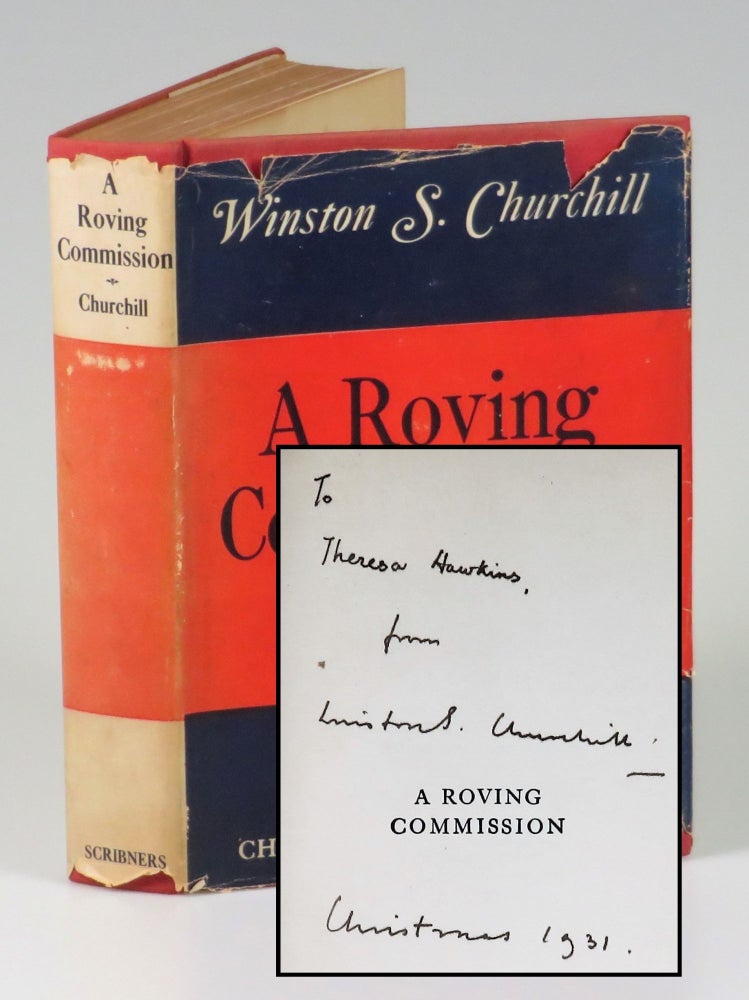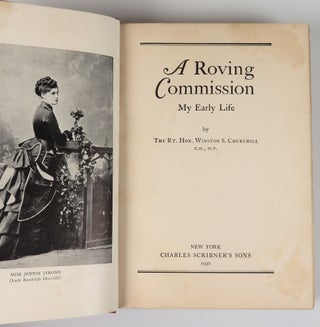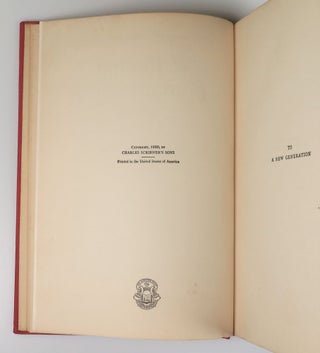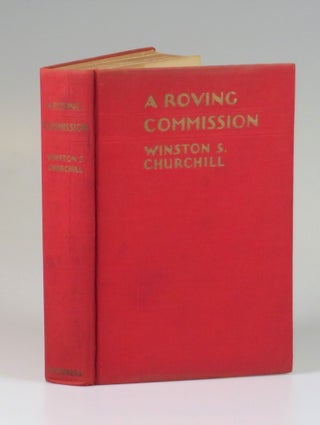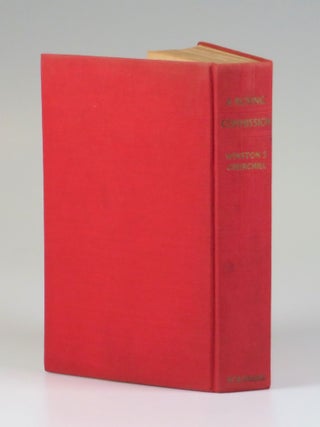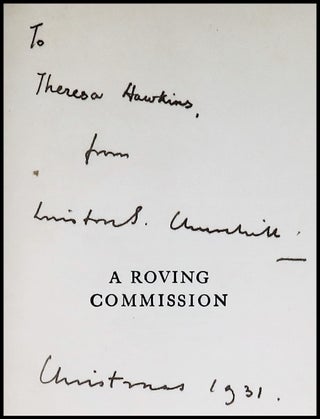A Roving Commission, a presentation copy inscribed and dated in New York City by Churchill on Christmas 1931 during his convalescence weeks after a near-fatal accident
New York: Charles Scribner's Sons, 1930. First edition, second printing. Hardcover. This is a presentation copy of the U.S. first edition, later printing of Churchill's extremely popular autobiography, inscribed in New York City in December 1931, just weeks after Churchill’s near-fatal accident, almost certainly as a Christmas gift to one of the people who aided his convalescence.
Edition and condition
This first edition, second printing is distinguished from the first printing by only a single character – namely absence of the Scribner’s “A” on the title page verso. This second printing’s binding, contents, and dust jacket are all otherwise identical to those of the first printing. The second printing, published in December 1930, swiftly followed the first printing of late October 1930.
The U.S. first edition was aesthetically striking, bound in a bright red-orange cloth with vertical and horizontal intersecting blind rules of varying thickness on the front cover and spine, these framing the gilt spine and front cover print. The contents feature untrimmed fore edges. The dust jacket front face and spine feature a bright red-orange center panel, complementing the binding, capped by white ends on the spine and by navy blue panels on the front face. The net aesthetic effect is commandingly bold and arresting – not unsuited to the author and content. Unfortunately, the red-orange cloth binding proved highly susceptible to fading and soiling and the thin, fragile dust jacket proved highly vulnerable to wear and severe fading, particularly on the jacket spine. Jacketed copies of the U.S. first edition are scarce and respectable unjacketed copies are unusual.
Condition of this inscribed presentation copy is very good plus in a good dust jacket. The binding remains square and tight with sharp corners, the orange-red hue of the cloth still vivid on the spine and covers. The binding shows only light handling and soiling and a hint of toning to extremities, corresponding to small dust jacket losses. The contents are respectably clean, modest spotting mostly confined to the endpapers and prelims, only light and occasional within the text. The sole previous ownership mark is the author’s inscription. Differential toning to the endpapers corresponds to the jacket flaps, confirming what the bright binding testifies - that this copy has spent life jacketed. The dust jacket is chipped and worn, but both unclipped, retaining the “$3.50” front flap price, and uncommonly bright, with the red-orange spine panel only faintly duller than that of the front face. The white spine panels and rear face show overall soiling, as does the navy panel of the lower front face. Closed tears and shallow losses are ubiquitous to the edges, the most significant being a 1.25 inch (3.2 cm) deep loss to the upper rear face corner. None of the losses impacts any print. The dust jacket is protected beneath a clear, removable, archival cover.
The moment
When he arrived in New York on 11 December 1931 to begin a lecture tour, Churchill had already been a Member of Parliament for more than a quarter of a century and held more than half a dozen Cabinet positions. But what lay ahead was arguably more remarkable still – more than thirty additional years in Parliament, as well as two premierships spanning more than eight and a half years at 10 Downing Street. This second act almost ended abruptly in New York.
Churchill’s near-corporeal death coincided with his political one. Churchill was at the beginning of his decade of “wilderness years” spent out of power and out of favor, frequently at odds with both his party and prevailing public sentiment. And in 1931 Churchill’s financial prospects were as threatened as his political future. 1929 saw the loss of Churchill’s ministerial salary as well as devastating financial loss following the stock market crash. This speaking tour was conceived to supplement the revenue Churchill was earning as a prolific writer.
Churchill arrived in New York on 11 December, later than he had intended, having been delayed by parliamentary business. Two days later, on 13 December, he received a dinner invitation from his old friend, Bernard Baruch. Churchill knew Baruch lived on Fifth Avenue and had been there several times, but he did not know the exact address. After he left his cab to search on foot, he was met with the peril of every transatlantic traveler; he looked the wrong way to cross the street – and was consequently struck by a car. Witnesses feared he had been killed.
“It was not until December 21 that Churchill was well enough to leave Lenox Hill Hospital and for two more weeks he had to remain in bed at the Waldorf-Astoria.” (Gilbert, Vol. V, p.421) Hence Churchill was convalescing at the Waldorf-Astoria when this book was inscribed. While we have been unable to learn more about the recipient, “Theresa Hawkins”, it seems probable to the point of near certainty that Ms. Hawkins was staff at either the Waldorf or the hospital, to whom Churchill felt sufficiently appreciative to make a gift of an inscribed book at Christmas. This was long a custom of Churchill for those who worked for him and held his regard, particularly at Christmas. This second printing of A Roving Commission would have notionally been available and procured for the occasion from a New York City bookseller, having been published late in 1930.
Certainly, given Churchill’s convalescence and confinement, this book was not inscribed for a mere sycophant or lecture attendee. Churchill’s lectures did not resume until 28 January 1932, following a further three weeks recovery in the Bahamas.
Churchill’s resumption of his lecture tour a month after he inscribed this book was not merely a public act of determination. The financial exigencies which had prompted the tour in the first place had not abated; the still-recuperating Churchill “undertook a tour of forty lectures throughout the United States, living all day on my back in a railway compartment, and addressing in the evening large audiences.” He later recalled “For two months I was a wreck… On the whole I consider this was the hardest time I have had in my life.” (WSC, WWII, Vol. I, p.78)
The book
Published in England as My Early Life, this is one of the few Churchill first editions for which the U.S. edition bears a different title than the British. Interestingly, A Roving Commission was the title proposed by Churchill himself and favored by his American publisher.
A Roving Commission covers the years from Churchill’s birth in 1874 to his first few years in Parliament. One can hardly ask for more adventurous content. These momentous and formative years for Churchill included his time as an itinerant war correspondent and cavalry officer in theaters ranging from Cuba, to northwest India, to sub-Saharan and southern Africa. Churchill also recounts his capture and escape during the Boer War, which made him a celebrity and helped launch his political career.
Herein Churchill says:
"Twenty to twenty-five! These are the years!
Don't be content with things as they are.
'The earth is yours and the fulness thereof'.
Enter upon your inheritance, accept your responsibilities....
Don't take No for an answer. Never submit to failure...
You will make all kinds of mistakes; but as long as you are generous and true,
and also fierce, you cannot hurt the world or even seriously distress her.
She was made to be wooed and won by youth." (p.60)
By the end of his own twenty-fifth year, Churchill had been one of the world’s highest paid war correspondents, published his first five books, made his first lecture tour of North America, braved and breasted both battlefields and the hustings, and been elected to Parliament, where he would take his first seat only weeks after the end of Queen Victoria’s reign.
A Roving Commission remains one of the most popular and widely read of all Churchill's books. And for good reason, as the work certainly ranks among the most charming and accessible of his many books. An original 1930 review likened it to a "beaker of Champagne." That effervescent charm endures; a more recent writer called it "a racy, humorous, self-deprecating classic of autobiography." To be sure, Churchill takes some liberties with facts and perhaps unduly lightens or over-simplifies certain events. Nonetheless, the factual experiences of Churchill’s early life would compete with any fiction, and any liberties or simplifications are forgivable, in keeping with the wit, pace, and engaging style that characterize the book.
Reference: Cohen A91.2.b, Woods/ICS A37(b.2), Langworth p. 134. Item #006782
Price: $10,000.00

